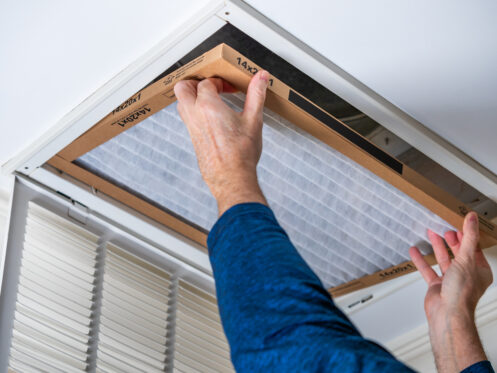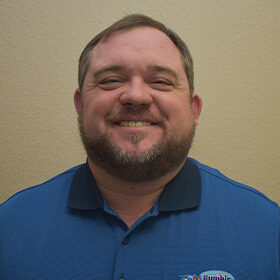Living in Nevada comes with big blue skies, stunning desert views, and plenty of dust. During the dry months, sudden dust storms and strong winds can cover your home with a fine layer of particulate matter in mere minutes. While you can hose off your patio or sweep your driveway, your HVAC system can be harder to protect from that swirling desert dust that covers and gets inside it.
When dust and sand get inside your heating and cooling system, they can clog filters, coat coils, reduce airflow, and strain key components. Left unchecked, this extra dirt and debris will shorten your system’s lifespan, increase your energy bills, and make indoor air quality worse in your home. With a few smart habits and regular maintenance, you can protect your HVAC system from the dust storms in Las Vegas, NV.
How Do Dust Storms Threaten Your HVAC System?
Nevada’s desert winds kick up all kinds of fine particles. When a dust storm hits, that debris doesn’t just settle on outdoor furniture; it sneaks into every crack and crevice around your home. Your HVAC system, with its air intake and exhaust vents, is especially vulnerable.
Dust storms can cause air filters to clog. When your filters fill up quickly with dust, they can’t trap new particles effectively. Dirty filters reduce airflow, causing your system to work harder than necessary. Dust can also coat the evaporator and condenser coils, lower efficiency, and cause the system to run longer to reach your desired temperature in your living space.
Excessive debris in the ductwork can block ducts and restrict air circulation, creating hot and cold spots around your home. When your system pulls in dusty air, it can push those particles back into your living spaces, aggravating those with allergies and other respiratory issues.
Replace or Clean Air Filters Regularly
Your HVAC filter is your first line of defense against dust storms. A good filter will trap dust, pollen, and other airborne debris before it can reach your system’s internal components. However, during a dust storm, filters fill up fast.
Since you live in Nevada, you should check your filter at least once a month during the dry, windy season. If it looks gray or clogged with debris, replace it. Some filter types also allow you to wash them between changes to keep the filter cleaner. A fresh filter helps your system maintain proper airflow and keeps your indoor air clean as well.
Consider upgrading to a higher-quality filter with a better MERV (Minimum Efficiency Reporting Value) rating if your system can handle it. Just make sure your filter isn’t so restrictive that it puts unnecessary strain on your blower motor.
Schedule HVAC Maintenance Sessions
Professional maintenance is one of the best investments you can make to protect your system from Nevada’s harsh environment. During a professional inspection, a licensed HVAC technician from our team will do the following:
- Clean the condenser and evaporator coils
- Inspect and clear the blower fan and housing
- Check ductwork for signs of blockages or leaks
- Test refrigerant levels
- Evaluate system efficiency
Be sure to schedule an annual inspection and maintenance with our team. At Bumble Breeze, we suggest maintenance sessions twice a year to keep your HVAC system clean and ready to handle everything, from scorching summer heat to sudden dust storms.
Seal Ducts and Vents
Leaky ducts are often a common issue in older homes. Even small gaps can allow a surprising amount of dust and debris to enter during a storm. This dust then gets circulated throughout your home. Having one of our team members inspect your ductwork to seal leaks and insulate exposed sections. Weatherstripping around doors and windows also keeps dust from blowing in. When you know a dust storm is approaching, shut windows tightly and close vents that lead directly outdoors to minimize infiltration.
Protect Your System’s Outdoor Unit
Your HVAC system’s outdoor condenser unit is outside in the elements year-round. During a dust storm, strong winds can blast sand and particulate matter right into the unit’s fins and coils. You can protect these components by clearing the area around your outdoor unit of loose debris, like leaves, branches, or yard waste, that can blow into the equipment. Trim plants or shrubs so they don’t shed leaves and dirt directly onto the unit.
Install a sturdy, breathable cover designed for your condenser when a severe dust storm is in the forecast. Just remember to remove it when the unit is in operation. Covering your unit while it operates can cause serious damage. An unobstructed outdoor unit is more efficient and less likely to overheat.
Consider Upgrading Your System
If your current HVAC system struggles with dust storms each year, an upgrade is something to consider. Most modern systems offer better filtration, tighter seals, and smart thermostats so you can easily monitor performance.
You can also install whole-home air purification systems or high-efficiency media filters to trap more particles than a standard filter can. These additions improve indoor air quality and keep your HVAC system cleaner between tune-ups. If you would like to upgrade your HVAC system, a member of our team can help you decide which options work best for your home.
Thinking of a whole-home air purification system? The benefits of an air purifier are endless!
Frequently Asked Questions: Protecting Your HVAC System for Dust Storms
Questions about how to protect your HVAC system from dust storms are common, especially if you are new to owning a home in the Las Vegas area. Let’s look at some of the more common questions so you are better informed.
How Often Should I Change My HVAC Filter?
During dry, windy months, check your filter every 30 days. You may need to do this more often if you see heavy dust buildup. In some cases, you may need to replace filters every 2 to 3 weeks during the worst dust storms. On average, filters last between 30 and 90 days when conditions are normal.
Should I Run My AC During a Dust Storm?
It’s usually fine to keep your AC running during a dust storm, especially if you need to maintain comfortable indoor temperatures. Make sure your home stays sealed tightly so that fewer dust particles can get inside. Always check your filters after a dust storm. If you have the option, turn off your HVAC system for the time being to reduce the amount of particulate matter that enters your home.
Can Dust Storms Damage an HVAC System?
Yes, a dust storm can damage your system. Excessive dust can clog filters, coat coils, overwork the blower motor, and even block ductwork. Over time, this will reduce efficiency, shorten your system’s lifespan, and increase your energy bills.
Stay Ahead of the Dust and Contact Bumble Breeze
A desert climate can be tough on your HVAC system. A few smart habits will help your equipment weather dust storms without breaking a sweat. Stay proactive by replacing filters, keeping up with maintenance, and sealing your ducts. With proper care, your system will keep you comfortable while preventing harsh desert dust from entering your home. If you’re concerned that your system isn’t ready to handle another season of dust storms, reach out to Bumble Breeze in Las Vegas. We’ll inspect your equipment, recommend upgrades, and help you breathe easier.


